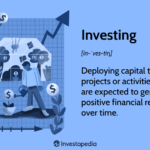Maximize Long-term Gains With Our Powerful Investment Strategies: Buy And Hold!
The Art of Investment: Strategies to Buy and Hold
Investing is like an intricate dance, where every move can significantly impact your financial future. Among the various investment strategies available, one approach that has gained popularity over the years is the buy and hold strategy. In this article, I will delve into the depths of this strategy, exploring its what, who, when, where, why, and how, shedding light on its intricacies, benefits, and potential drawbacks.
What is the Buy and Hold Strategy?
The buy and hold strategy is an investment approach that involves purchasing stocks, bonds, or other securities and holding onto them for an extended period, typically without actively trading or frequently buying and selling. The idea behind this strategy is to capitalize on the long-term appreciation of these assets, which tend to yield higher returns over time.
3 Picture Gallery: Maximize Long-term Gains With Our Powerful Investment Strategies: Buy And Hold!



Who Should Consider the Buy and Hold Strategy?
The buy and hold strategy is suitable for investors with a long-term investment horizon and a patient mindset. This approach requires discipline and the ability to withstand short-term market fluctuations without succumbing to panic selling. Investors who believe in the potential of the market and are willing to ride out its ups and downs can benefit greatly from this strategy.
When is the Right Time to Implement the Buy and Hold Strategy?

Image Source: usbank.com
The buy and hold strategy is most effective when implemented early on in an investor’s journey. Starting young allows investors to take advantage of the power of compounding and maximize their returns over time. However, it is never too late to adopt this strategy, as long as investors have a long-term perspective and are willing to hold their investments for an extended period.
Where Can You Implement the Buy and Hold Strategy?
The buy and hold strategy can be applied to various investment vehicles, including stocks, bonds, mutual funds, exchange-traded funds (ETFs), and real estate. It is essential to evaluate the investment options available and choose those that align with your long-term financial goals and risk tolerance.
Why Choose the Buy and Hold Strategy?
The buy and hold strategy offers several advantages. Firstly, it reduces the transaction costs associated with frequent trading, allowing investors to save on fees and commissions. Additionally, this strategy minimizes the impact of short-term market volatility, as investors are focused on the long-term growth potential of their investments. Moreover, it eliminates the need for constant monitoring and decision-making, making it a less time-consuming approach.
How to Implement the Buy and Hold Strategy?

Image Source: c-dn.net
Implementing the buy and hold strategy requires careful consideration and research. Here are some key steps to follow:
1. Define Your Financial Goals:
Before implementing any investment strategy, it is crucial to identify your financial goals. Determine your risk tolerance, time horizon, and desired returns to align your investments with your objectives.
2. Conduct Thorough Research:
Educate yourself about different investment options and the market conditions. Analyze the historical performance, future prospects, and track record of the assets you plan to invest in.
3. Diversify Your Portfolio:

Image Source: usbank.com
Spread your investments across various asset classes and industries to reduce risk and increase the potential for returns. Diversification helps cushion the impact of any individual investment’s poor performance.
4. Monitor Your Investments:
While the buy and hold strategy involves holding onto investments for an extended period, it is still essential to periodically review your portfolio’s performance. Rebalance if necessary to maintain your desired asset allocation.
5. Stay Informed:
Stay updated with market trends, economic indicators, and relevant news that can impact your investments. However, avoid making impulsive decisions based on short-term fluctuations.
Frequently Asked Questions (FAQ) about the Buy and Hold Strategy
Q: Is the buy and hold strategy suitable for all types of investors?
A: The buy and hold strategy is more suitable for long-term investors who can withstand market volatility and are focused on achieving long-term financial goals.
Q: How long should I hold onto my investments?
A: The duration of holding investments will vary depending on your financial goals and the performance of your investments. However, the buy and hold strategy typically involves holding investments for several years.
Q: Can the buy and hold strategy be applied to all types of assets?
A: While the buy and hold strategy can be applied to various assets, including stocks, bonds, and real estate, it may not be suitable for every investment. Conduct thorough research and consult with a financial advisor to determine the best approach for individual assets.
The Pros and Cons of the Buy and Hold Strategy
Like any investment strategy, the buy and hold approach has its advantages and disadvantages. Let’s explore:
Pros:
Reduced transaction costs
Minimized impact of short-term market fluctuations
Simplicity and time-saving
Long-term growth potential
Cons:
No guarantee of short-term gains
Potential for significant drawdowns during market downturns
Requires patience and discipline
May not be suitable for investors seeking quick returns
Conclusion: Embracing the Buy and Hold Strategy
The buy and hold strategy offers a compelling approach to long-term investing, allowing investors to harness the power of time and compounding for potentially higher returns. By staying focused on their financial goals and exercising patience during market fluctuations, investors can navigate the ups and downs of the market and build a resilient investment portfolio. However, it is crucial to conduct thorough research, seek professional advice, and continuously monitor investments to ensure alignment with changing market conditions. Embrace the buy and hold strategy as a cornerstone of your investment journey and let time work its magic.
This post topic: Personal Finance


